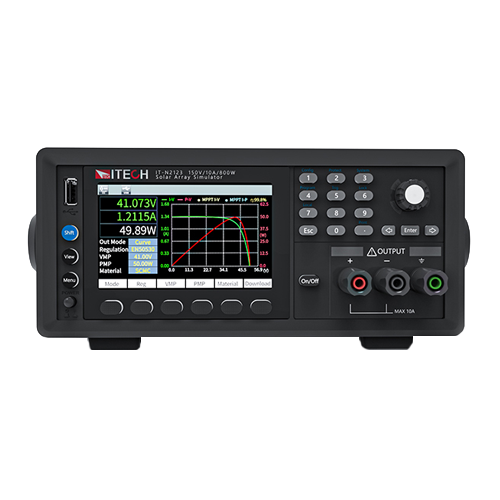IT-N2100 series solar array simulator is a high-performance DC power supply with fast changing IV curve, which is used to simulate the IV output characteristics of various solar panels in different environments (temperature, illumination, shadow attenuation, aging degree). It can be used for testing and validation of solar microinverters, power optimizers, satellite power systems, and sail panel power arrays. The series features low ripple and low noise and high speed MPPT tracking speed, multi-channel synchronous control and high voltage withstand topology.
Accurately simulate the IV characteristics of silicon, GaAs and other types of solar PV panels.
Standard solar matrix simulation software, support multi-channel control
High speed current dynamic response to support high speed MPPT tracking speed for microinverters
Up to 1500V DC output common-mode withstand voltage, support the object to be tested in series test
Fixed mode, adjustable output impedance, can simulate constant voltage and current constant power output.
Ultra-low current ripple, high-precision sampling, programming and measurement.
Simulate I-V curves under different temperatures and lighting environments.
Built-in EN50530, Sandia, NB/T32004, CGC/GF004, CGC/GF035
5 kinds of regulations and dynamic model testing, and generate reports
Graphical operation interface, real-time display of MPPT status of PV inverters.
Dynamic List Sequence Programming: 100 steps x 20 groups of data.
Real-time data and curve recording for further analysis
Simulate the dynamic and static I-V curves of solar panels under cloud cover.
Table mode supports I-V curve fitting with 4096 points.
Quickly generate I-curve by setting Voc,lsc,Vmp,lmp in four-point method.
Comprehensive protection: OVP, OCP, OPP, OTP
Small size: 1/2 2u single channel
4.3 “LCD HD screen, easy to use panel and host computer software.
Front and rear panel outputs, adaptable to desktop and system integration of a variety of occasions
Standard LAN, USB, digital I/0 communication interface, support for SCPI protocols











